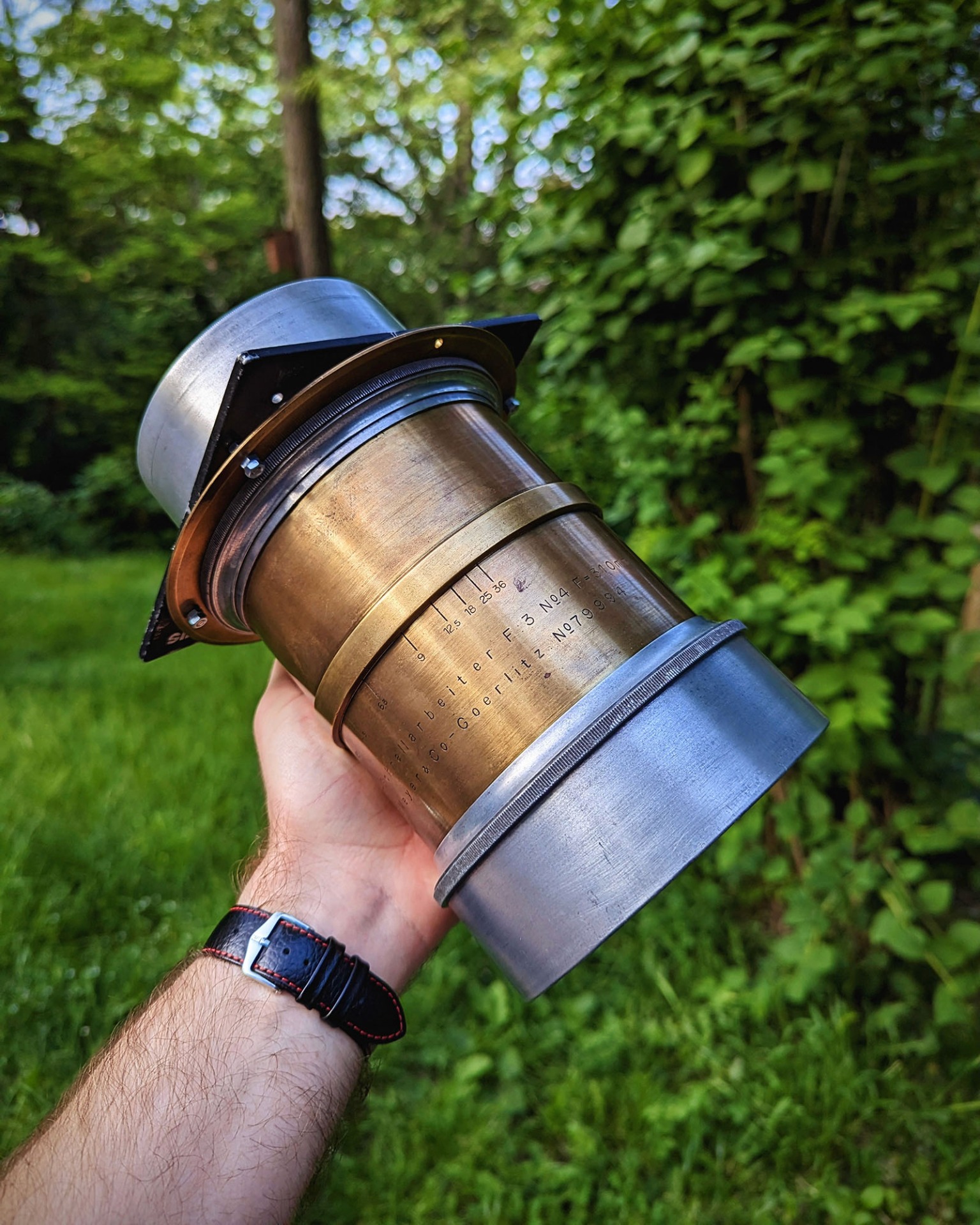#4 Hugo Meyer Atelier Schnellarbeiter 310mm f3
We have tiny lenses. A little bigger. Then a medium one, a larger one, and the largest. And then there are the very biggest ones - and this is one of them. The internal code names are "big beast," "leviathan," and "hand me that thing."

Today we're going to talk about brass and aluminium. This lens is made of brass and aluminium. We've done our education on the materials side of things, and now we're going to please the linguists - it's a Hugo Meyer Atelier Schnellarbeiter 310mm f3, which the translator peculiarly translates as "fast worker."
- The term speed in photographic jargon embodies aperture - the larger aperture, the faster the lens (because you can use faster shutter speeds, duh!!).
I was reprimanded by a reader for calling it aluminum, when in fact it's an aluminum alloy. I'm pleased that the article stirred up debate even among metallurgists. Hopefully at least the brass is actually brass.
Anyway, this lens was born sometime between 1910-1914 (soon afterwards there were troubles with a̶l̶u̶m̶i̶n̶u̶m̶ aluminum alloys shortages caused by WWI). It was the absolute top of its time and the showcase of the Hugo Meyer company, which apart from the absolutely insane f3 aperture (only a few manufacturers in history managed to reach or perhaps surpass this mark) is also evidenced by the use of selected materials ensuring low weight despite its size or the not very common presence of a really-lot-of-blades aperture.
- You're not going to impress anyone with an f3 aperture these days. But back then? Hell yeah. Plus - today's lenses can barely cover a few centimeters and even at that, they get out of breath. This behemoth will cover about 18x24cm and believe me - f3 aperture on FF or APS-C is really not the same as on large format. Here, that means you have a depth of field (DoF) of about a millimeter or so and hitting what you want sharp requires the hands of a surgeon and a patient (ideally dead or inanimate) subject to photograph (the ladies below were live during the shooting and I hereby pay tribute to them). If you wanted to convert the aperture on this format to 35mm (FF), you'd come up with some number from dreamland - f0.5 or some such monstrosity). Impressive.
- Besides the smaller siblings, there were also two larger variants with focal lengths of 360 and 400mm. Even rarer, even more monstrous. You might also come across black-and-gold or just gold-colored specimens. Come to think of it, this particular gold-and-silver combo is probably the one I've seen the least.
The sharpness in the centre (the centre of the picture, not the city, it shoots sharply even on the edges of towns and villages, hohoho) is absolutely nuts for something made 110 years ago - towards the edges then stands out the pleasing swirl bokeh typical for petzval designs.
- I'll probably bring some coal to Newcastle, but just to be safe: bokeh is the out-of-focus part of the image behind the focused object. The more open the aperture, the blurrier the background. The quality and shape of the bokeh depends on the construction of the glass, the shape of the aperture or even the number of blades. The more you close the aperture, the more the bokeh disappears.
- Swirl is the ability of the lens to "spin" the bokeh in the background - you can see the swirl effect in the second photo. Some designs are famous for it, some don't have it at all. The strength of the swirl effect, like bokeh, is closely tied to the open aperture, the direction of the light, and the ruggedness of the background. It is actually an optical defect of the uncorrected design. And we thanks for these defects.
The obvious drawback should be pretty clear when compared to my delicate little lady hand - it's not small. I dare say it's borderline unportable. I had an entire "Best Of" list of classic jokes ready: The bigger the lens, the better the photographer, or the evergreen Even with a tiny puppet you can put on a grand show, not to mention the timeless crowd-pleaser Hehe, what are you compensating for? In any case, the sheer size of the thing makes it look like someone at Meyer chopped off a piece of an oil pipeline, stuffed it with glass and engraved "ATELIER" on the barrel in massive letters – just in case even the densest moron who's mastered the alphabet gets the hint: this is a studio lens. It's not meant to be dragged outdoors. Naturally, I only ever take it outdoors. But before I had to go through the first problem: adapting it to the camera. It pushed the absolute limits of the Sinar lens board, but hey, it worked. Let that be a comforting note to anyone plagued by self-doubt: don't despair, anyone can take photos. Even a piece of pipe.